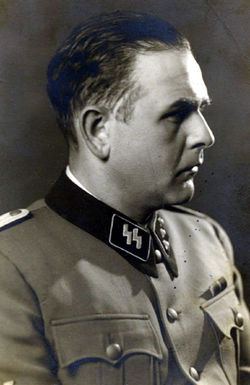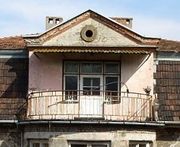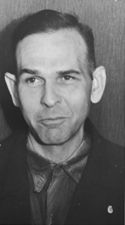Amon Göth
| Amon Leopold Göth | |
|---|---|
| 11 December 1908 – 13 September 1946 (aged 37) | |
 |
|
| Place of birth | Vienna, Austria-Hungary (now Austria) |
| Place of death | Kraków, Poland |
| Allegiance | |
| Service/branch | |
| Years of service | 1930-1945 |
| Rank | Hauptsturmführer |
| Unit | |
| Commands held | Arbeitslager KL-Plaszow |
| Other work | SS-Wirtschafts-Verwaltungshauptamt |
Amon Leopold Göth (11 December 1908 – 13 September 1946; pronounced [ˈɡøːt]) was an Austrian Nazi war criminal. A Hauptsturmführer (Captain) of the SS, he was the commandant of the Nazi concentration camp at Płaszów, General Government (a German-occupied area of Poland).
After the war, the Supreme National Tribunal of Poland at Kraków found Göth guilty of murdering tens of thousands of people. He was executed by hanging on September 13, 1946, age 37, not far from the former site of the Płaszów camp.
Contents |
Early life and career
Göth was born in Vienna, then the capital of the Austro-Hungarian Empire, to a family in the printing industry. At the age of 22, Göth became a member of the Austrian branch of the Nazi Party. In 1930, he was assigned the Party Number 510764. Göth simultaneously joined the Austrian SS and was appointed an SS-Mann with the SS Number 43673.
Göth's early SS activities are little known, largely because the Austrian SS was an illegal and underground organization until the Anschluss of Austria by Nazi Germany in 1938. Between 1932 and 1936, Göth was a member of an Allgemeine-SS company in Vienna and, by 1937, had risen to the rank of SS-Oberscharführer (Staff Sergeant). Between 1938 and 1941, he was a member of 11th SS-Standarte operating from Vienna and was commissioned an SS-Untersturmführer (Second Lieutenant) on 14 July 1941.
Płaszów
In August 1942, Göth left Vienna to join the staff of SS-Brigadeführer Odilo Globočnik, the SS and Police Leader of Kraków.[1] He was appointed as a regular SS officer of the Concentration Camp service, and on 11 February 1943 was assigned to construct and command a forced labour camp at Płaszów. The camp took one month to construct using slave labour and, on 13 March 1943, the Jewish ghetto of Kraków was closed down with the surviving inhabitants imprisoned in the new labour camp. Approximately 2,000 people died during the evacuation. At his war crimes trial, Göth was accused of having personally shot many people during the action.[2]
On 3 September 1943, Göth was further tasked to close down the ghetto at Tarnów, where an unknown number of people were killed on the spot. On 3 February 1944, Göth shut down the concentration camp at Szebnie by ordering the inmates to be murdered on the spot or deported to other camps, again killing several thousand people.

By April of 1944, Göth had been promoted to the rank of SS-Hauptsturmführer (Captain), having received a double promotion and thus skipping the rank of SS-Obersturmführer (First Lieutenant). He was also appointed a reserve officer of the Waffen-SS. His assignment as Commandant of the Płaszów Labour Camp continued, now under the direct authority of the SS Economics and Administration Office.
It was Göth's firm belief that the Jews themselves should pay for their own execution, and it was wholly in this spirit when on 11 May 1942, in the small town of Szczebrzeszyn, the Gestapo ordered the Jewish council to pay 2,000 złoty and 3 kilos of coffee to cover the expenses for the ammunition used to kill the Jews.[3]
In Płaszów, Göth tortured and murdered prisoners on a daily basis. During his time at Płaszów, Göth allegedly shot over 500 Jews himself; Poldek Pfefferberg, one of the Schindler Jews, said, "When you saw Göth, you saw death." Göth spared the life of a Jewish prisoner Natalia Hubler, later famous as Natalia Karp, after hearing her play a Nocturne by Chopin on the piano the day after she arrived at the Płaszów camp.
Later military career
On 13 September 1944, Göth was relieved of his position as Commandant of Płaszów and was assigned to the SS Office of Economics and Administration. Shortly thereafter, in November 1944, Göth was charged with theft of Jewish property (which, according to Nazi legislation, belonged to the Reich), and was arrested by the Gestapo. He was scheduled for an appearance before SS judge Georg Konrad Morgen, but due to the progress of World War II, and Germany's looming defeat, a tribunal was never assembled and the charges against him were summarily dismissed.
He was next assigned to Bad Tölz, Germany, where he was quickly diagnosed by SS doctors as suffering from mental illness and diabetes. He was committed to a sanatorium where he was arrested by American troops in May 1945. At the time of his arrest, Göth claimed to have been recently promoted to SS-Sturmbannführer and, during later interrogations, several documents listed him as "SS-Major Göth". Rudolf Höß was also of the opinion that Göth had been promoted and, when called to give testimony at Göth's trial, indicated that Göth was an SS-Major in the Concentration Camp service.
Göth's service record, however, does not support the claim of a late war promotion and he is listed in most texts as having held the rank of SS-Hauptsturmführer equivalent of a Captain.[4]
Execution

After the war, the Supreme National Tribunal of Poland at Kraków found Göth guilty of murdering tens of thousands of people. He was hanged on September 13, 1946, age 37, not far from the former site of the Płaszów camp. At his execution, Göth's hands were tied behind his back. The executioner twice miscalculated the length of rope necessary to hang Göth, and it was only on the third attempt that the execution was successful.[5] The execution of Göth was shot with a movie camera in black and white and the footage exists still today and is also available on some video-sharing sites on the Internet.
In 2002, an interview book with Göth's daughter, Monika, was published in Germany under the name "Ich muß doch meinen Vater lieben, oder?" (I still have to love my father, don't I?). For the first time, Göth's daughter spoke of her mother, who unconditionally glorified her father until faced with his role in the Holocaust, and had committed suicide after giving an interview in the 1980s.[6]
Göth's daughter's experiences in dealing with the legacy of her Nazi father's crimes are detailed in Inheritance, a 2008 documentary directed by James Moll.[7] Also appearing in the documentary is Helen Jonas, who was one of Amon Göth's slaves at his villa. The documentary details the meeting of the two women at the Płaszów memorial site in Poland.
Depiction in Schindler's List
Göth's career at Płaszów Labour Camp became internationally known through his depiction by Ralph Fiennes in the movie Schindler's List; Fiennes earned an Academy Award nomination for Best Supporting Actor, and his portrayal ranked 15 on AFI's list of the top 50 film villains of all time. Notably, he ranks as the highest non-fiction villain. When Mila Pfefferberg, a surviving Schindler Jew, was introduced to Fiennes while on the set of the film, she began to shake uncontrollably in terror, as Fiennes—while in full SS-Hauptsturmführer uniform—reminded her of the real Göth.[8] At the end of the film, Göth is shown at his hanging, patting his hair in place and saying "Heil Hitler" just before a Russian soldier kicks the chair out from under him.[9] The film does not depict the unsuccessful attempts at execution or show his hands tied behind his back (they are in front), but does show a number of attempts to kick out from under his feet the chair on which he was standing.
Summary of SS career
- SS number: 43673
- Nazi Party number: 510764
- Primary Positions: Lagerkommandant, Kraków-Płaszów concentration camp
- Waffen-SS service: SS-Hauptsturmführer der Reserve
Dates of rank
- SS-Mann: c. 1930
- SS-Oberscharführer: c. 1937
- SS-Untersturmführer: July 14, 1941
- SS-Hauptsturmführer: August 1, 1943
- SS-Hauptsturmführer der Reserve die Waffen-SS: April 20, 1944
Awards
- Anschluss Medal
- German National Sports Badge (Silver)
- SS Julleuchter
- Honour Chevron for the Old Guard
References
- ↑ Crowe, David (2007). Oskar Schindler. Basic Books. p. 226. ISBN 0465002536. http://books.google.ca/books?id=EYOu2o3h1OwC. Retrieved 17 December 2008.
- ↑ "Trial of Amon Leopold Goeth". http://www.ess.uwe.ac.uk/WCC/goeth.htm. Retrieved 17 December 2008.
- ↑ http://www.jewishgen.org/Yizkor/belzec1/bel070.html "JewishGen, Inc. makes no representations regarding the accuracy of the translation. The reader may wish to refer to the original material for verification. JewishGen is not responsible for inaccuracies or omissions in the original work and cannot rewrite or edit the text to correct inaccuracies and/or omissions. Our mission is to produce a translation of the original work and we cannot verify the accuracy of statements or alter facts cited."
- ↑ SS service record of Amon Göth, National Archives and Records Administration, College Park, Maryland.
- ↑ Isabelle Clarke and Danielle Costelle, La Traque des Nazis 1945-2005, soixante ans de traque (film documentary) (French)
- ↑ Kessler, Matthias (2002) (in German). Ich muß doch meinen Vater lieben, oder?. Eichborn. ISBN 978-3821839141.
- ↑ PBS Inheritance web site.
- ↑ RICHARD CORLISS (1994-02-21). "The Man Behind the Monster". Time Magazine. http://www.time.com/time/magazine/article/0,9171,980191-1,00.html. Retrieved 2008-08-14.
- ↑ Bülow, Louis (2007). "The Nazi Butcher: Amon Göth". http://www.auschwitz.dk/goeth.htm. Retrieved 2007-03-12.
External links
- [1] - footage of Amon Göth's execution
- The Trial of Amon Göth
- Voices on Antisemitism' Interview with Helen Jonas from the United States Holocaust Memorial Museum
- Voices on Antisemitism Interview with Ralph Fiennes from the U.S. Holocaust Memorial Museum
|
|||||||||||||||||||||||||||||||||||||||||||||||||||||||||||||||||||||||||||||||||||||||